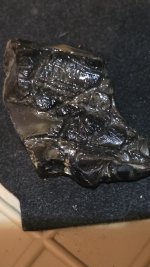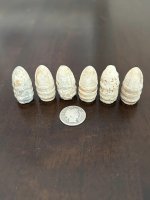bigscoop
Gold Member
- Jun 4, 2010
- 13,373
- 8,689
- Detector(s) used
- Older blue Excal with full mods, Equinox 800.
- Primary Interest:
- All Treasure Hunting
Technology and Beach Hunting....are you getting the most from what's out there?
Technology and Beach Hunting
Yep, some of the technology at our fingertips these days is pretty amazing so I'm going to take a few minutes to introduce some of you to Google Earth so can evaluate for yourself if you're getting the full jest of how this fantastic tool can possibly lead you to more treasure.
Sand, we all know it is always moving, building, and being removed. But have you ever wondered just how much, or just how often that sand moves? True, once we become familiar with a particular beach we can pretty much get a fix on these things with the naked eye, but what about that sand beyond the waterline, especially along those coastal areas where visibility is limited to just the first few feet of water?
It may surprise you to learn that on many beaches the bottom is always moving and changing, even when conditions remain fairly steady and/or mild. So for the purpose of explanation let's consider the series of troughs and sandbars along my area beaches here at New Smyrna Beach. Basically, from one summer to the next they seem pretty much the same, at least above the waterline anyway. But when we apply some of the basic tools incorporated in Google Earth we can begin to see that the beach is anything but the same, especially beyond the waterline. So here's an easy way to determine just how much your area beaches change from one year to the next.
Once you isolate a section of beach on your screen drop down to an elevation under 1000ft. Next, locate a couple of fixed points like the edge of a seawall, a pier piling, etc. From these fixed locations you want to use the ruler to take a distance measurement from the fixed point to say, the outer edge of the first trough, take note of that distance. Basically you have established the distance from your fixed object to the first underwater sandbar. Now prepare to be amazed.
Google Earth allows you to step back in time, sometimes a few months and sometimes several years, just depends on what year you're working in and how many aerial images are available for that year. At any rate, use the slide bar to choose a new period in time, say go back one year. Bring the same section of beach into your screen at nearly the same elevation, find your fixed position and then use the ruler to take another measurement from that fixed object to the same general area of that first sandbar. What you will often encounter is a huge difference in the location of that sandbar, meaning of course that the entire beach beyond the waterline has relocated a massive amount of sand and quite often by a considerable distance. Now consider the bottom of the trough, where it once was and where it is at the last aerial update. Think you might know where something lays hidden and buried beyond that waterline? Is the bottom of that trough the same bottom you hunted last year or is it a completely different bottom then six-months ago? Google Earth can certainly help you in determining these things and many others. Just one of the many ways these free technology apps can be used in your treasure hunting efforts.
Anyone care to share another?
Technology and Beach Hunting
Yep, some of the technology at our fingertips these days is pretty amazing so I'm going to take a few minutes to introduce some of you to Google Earth so can evaluate for yourself if you're getting the full jest of how this fantastic tool can possibly lead you to more treasure.
Sand, we all know it is always moving, building, and being removed. But have you ever wondered just how much, or just how often that sand moves? True, once we become familiar with a particular beach we can pretty much get a fix on these things with the naked eye, but what about that sand beyond the waterline, especially along those coastal areas where visibility is limited to just the first few feet of water?
It may surprise you to learn that on many beaches the bottom is always moving and changing, even when conditions remain fairly steady and/or mild. So for the purpose of explanation let's consider the series of troughs and sandbars along my area beaches here at New Smyrna Beach. Basically, from one summer to the next they seem pretty much the same, at least above the waterline anyway. But when we apply some of the basic tools incorporated in Google Earth we can begin to see that the beach is anything but the same, especially beyond the waterline. So here's an easy way to determine just how much your area beaches change from one year to the next.
Once you isolate a section of beach on your screen drop down to an elevation under 1000ft. Next, locate a couple of fixed points like the edge of a seawall, a pier piling, etc. From these fixed locations you want to use the ruler to take a distance measurement from the fixed point to say, the outer edge of the first trough, take note of that distance. Basically you have established the distance from your fixed object to the first underwater sandbar. Now prepare to be amazed.
Google Earth allows you to step back in time, sometimes a few months and sometimes several years, just depends on what year you're working in and how many aerial images are available for that year. At any rate, use the slide bar to choose a new period in time, say go back one year. Bring the same section of beach into your screen at nearly the same elevation, find your fixed position and then use the ruler to take another measurement from that fixed object to the same general area of that first sandbar. What you will often encounter is a huge difference in the location of that sandbar, meaning of course that the entire beach beyond the waterline has relocated a massive amount of sand and quite often by a considerable distance. Now consider the bottom of the trough, where it once was and where it is at the last aerial update. Think you might know where something lays hidden and buried beyond that waterline? Is the bottom of that trough the same bottom you hunted last year or is it a completely different bottom then six-months ago? Google Earth can certainly help you in determining these things and many others. Just one of the many ways these free technology apps can be used in your treasure hunting efforts.
Anyone care to share another?
Amazon Forum Fav 👍
Upvote
0






